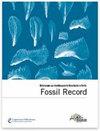早餐吃鸡蛋?白垩纪棘类动物Echinocorys ovata Leske, 1778年可能的沧龙咬痕分析
IF 2.1
4区 地球科学
Q1 PALEONTOLOGY
引用次数: 8
摘要
摘要化石咬痕(praedichnia)代表了捕食的间接证据,并揭示了化石捕食者-猎物的相互作用和化石食物网。尤其是棘皮动物的骨骼,咬痕是众所周知的。在这里,我们描述了1778年来自Hemmoor(德国北部)的白垩纪(马斯特里赫特阶)大型棘皮动物的口腔表面,该动物展示了四个排列成半圆弧的圆形穿孔,在骨架上留下一道长长的切口。穿刺对海胆来说并不是致命的,因为骨骼再生和骨折闭合的进展表明了这一点。穿孔的整体外观表明,它们是在一次机械事件中产生的,很可能是由大型脊椎动物的牙齿的叮咬作用引起的。我们分析了咬痕的形状和排列,得出的结论是,它可能是由一只拥有前颌牙齿位置的海燕产生的,最有可能是由球状的单棘龙产生的。我们的发现不仅揭示了mosasaur的觅食行为和猎物选择,还增加了对白垩纪最上层白垩系海洋生态系统中食物网的了解。本文章由计算机程序翻译,如有差异,请以英文原文为准。
Eggs for breakfast? Analysis of a probable mosasaur biting trace on the Cretaceous echinoid Echinocorys ovata Leske, 1778
Abstract. Fossil biting traces (praedichnia) represent indirect evidence of predation
and shed light on fossil predator–prey interactions and fossil food webs.
Especially from echinoderm skeletons, biting traces are well known. Here, we
describe the oral surface of a large Cretaceous (Maastrichtian) holasteroid
echinoid Echinocorys ovata Leske, 1778 from Hemmoor (northern Germany) which exhibits
four circular punctures arranged in a semi-circular arc. Whereas
three of the punctures penetrated the skeleton, one puncture only just hit
the margin of the echinoid test at the ambitus, leaving a long incision
furrow in the skeleton. The punctures were not lethal to the sea urchin as is
indicated by progressed skeletal regeneration and closure of the fractures.
The overall appearance of the punctures suggests that they were produced
during a single mechanical event, most likely by the biting action of the
teeth of a large vertebrate animal. We analysed the shape and arrangement of
the biting trace and conclude that it was probably produced by a marine
reptile possessing a prognath tooth position, most likely by a globidensine
mosasauroid. Our finding not only sheds light on mosasaur feeding behaviour
and prey selection but also increases the knowledge of the food webs in the chalk sea
ecosystem during the uppermost Cretaceous.
求助全文
通过发布文献求助,成功后即可免费获取论文全文。
去求助
来源期刊

Fossil Record
PALEONTOLOGY-
CiteScore
3.60
自引率
7.10%
发文量
18
审稿时长
14 weeks
期刊介绍:
Fossil Record (FR) is the palaeontological journal of the Museum für Naturkunde Berlin. This journal was founded in 1998 under the name Mitteilungen aus dem Museum für Naturkunde Berlin, Geowissenschaftliche Reihe and appears with two issues each year. Fossil Record publishes original papers in all areas of palaeontology including the taxonomy and systematics of fossil organisms, biostratigraphy, palaeoecology, and evolution. All taxonomic groups are treated, including invertebrates, microfossils, plants, and vertebrates.
 求助内容:
求助内容: 应助结果提醒方式:
应助结果提醒方式:


